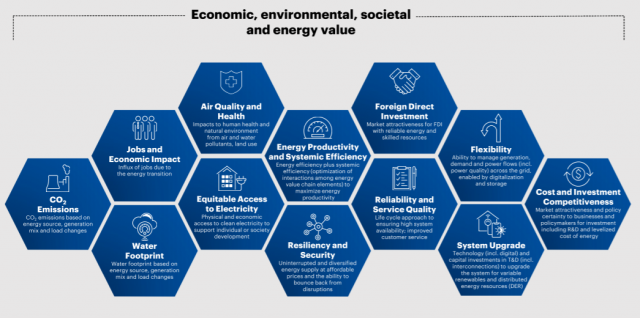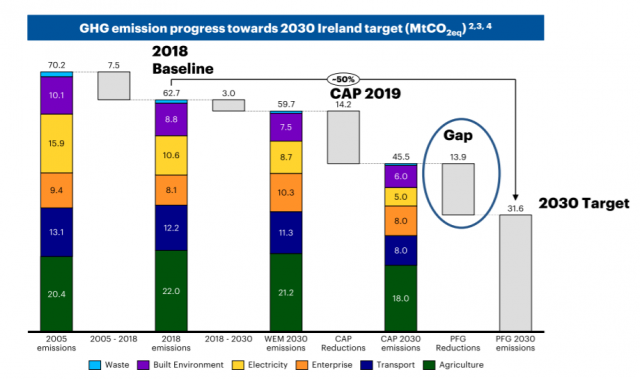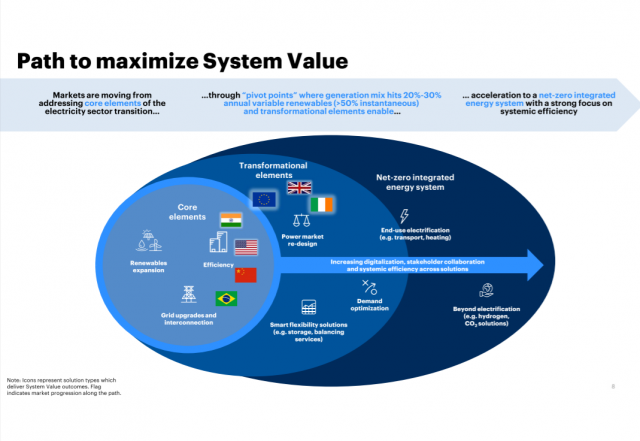
THE VALUE OF ENERGY: A NEW FRAMEWORK FOR THE TRANSITION TO NET ZERO
This is the second presentation of the REthink Energy: Countdown to COP26 lecture series, co-organised by the IIEA and ESB. On this occasion, three expert speakers will assess a new framework for energy solutions, developed by the World Economic Forum in partnership with Accenture, which shifts the political and commercial focus beyond cost to include value.
In collaboration with ESB, Accenture has applied this new System Value Framework (SVF) to Ireland to assess pathways to achieve 7% annual emissions reductions per annum to 2030. The SVF seeks to evaluate economic, environmental, social, and technical outcomes of potential energy solutions – not just their cost implications. Kristen Panerali will outline the key features of this new framework, while Stephanie Jamison will share the findings of the Irish market analysis. Finally, Dr Paul Deane will highlight the potential opportunities that the framework presents to achieve Ireland’s 2030 climate and energy targets.
About the Speakers:
Dr Paul Deane is a senior research fellow in clean energy futures at the Environmental Research Institute’s MaREI Centre in UCC. He has authored and co-authored over 120 technical papers on the future of energy in areas such as electricity markets, European and global power systems, renewable energy integration and energy access. He was first author on Ireland’s Low Carbon Roadmap in 2015 and provides technical assistance to several electricity modelling projects in Ireland and Europe. Dr Deane is an active contributor to European policy thinking on clean energy and in 2019 was the Royal Irish Academy speaker in computer science and engineering.
Kristen Panerali is Head of Electricity at the World Economic Forum (WEF). She focuses on enabling public and private sector activity to identify the most effective policies, actions, and cooperation to accelerate the energy transition. Ms. Panerali has 20 years of experience in the government and energy-related private sector. Prior to joining the WEF, she worked in electricity sector strategy, acquisitions, project development and financing with the AES Corporation, AES Solar and SunEdison. Previously, Ms. Panerali worked at the White House in various political roles at the National Economic Council and Office of Management and Budget.
Stephanie Jamison is the Global Industry Lead for Accenture’s Utilities business, responsible for a portfolio of services across the utility value chain. Ms. Jamison has a proven track record of helping clients with energy transition and growth strategies while driving business transformation programs with utilities in North America and Europe. Stephanie conducts research and has published articles related to the Digitally Enabled Grid and the New Energy Consumer and is a World Economic Fellow with the Energy and Materials industry platform.
If you missed the event you can view the recording below:
5 Key Takeaways
1. The System Value Framework (SVF), developed by the World Economic Forum and Accenture, seeks to evaluate the economic, environmental, social, and technical outcomes/impacts of potential energy solutions – not just their cost implications.
2. Kristen Panerali remarked that this new framework has been applied across a diverse range of international markets, all with varying degrees of renewables in the energy mix, to assist the recovery from the effects of the COVID-19 pandemic and to help forge a clean energy transition.
3. The SVF has been applied to the Irish market with a focus on how to meet Ireland’s ambitious target of 7% annual emissions reductions by 2030. The analysis identifies 6 solutions which will make a significant contribution to meet the 2030 target.
4. The holistic analysis of the Irish market finds that implementing the solutions would create between 17,000 and 28,000 jobs by 2030 and produce human health benefits of €167 million by the end of the decade.
5. Dr Paul Deane argued that the system value framework provides a new vocabulary and will help to forge a new narrative about the transition to net-zero emissions. He remarked that it will assist policymakers as they seek to communicate the issue of decarbonising the Irish economy.
Dr Paul Deane of MaREI to take part in the second installation of the ‘REthink Energy: Countdown to COP26’ lecture series.
@MaREIcentre's Dr. Paul Deane reflects on the importance of discussing and reflecting on our values as well as CO2 emissions when we tease out how to meet the challenges of a 51% GHG reduction by 2030 at the #RethinkEnergy lecture on the transition to #NetZero. pic.twitter.com/9UU8qeR31C
— Brian O Gallachoir (@BOGallachoir) May 10, 2021
A Holistic Framework for the Transition to Net-Zero Emissions
In her introduction to the framework, Kristen Panerali highlighted that an increasing number of national governments, cities, and businesses are committed to a net-zero future in the build up to the UN COP26 summit in Glasgow in November 2021. This will require largescale transformations across a range of industries, and the SVF, she remarked, offers a new lens for making investment decisions, for helping with national economic planning and shifting decision making from a perspective which is solely focused on cost to one which also incorporates value.

Figure 1. The desired outcomes of the energy system.
Ms. Jamison provided the audience with a visual representation of the system value framework. Each of the hexagons in Figure 1 represent a desired outcome of the energy system. While cost is considered, a range of other quantitative and qualitative outcomes are also incorporated. Ms. Jamison remarked that the SVF has been tested through bottom-up analyses across diverse markets such as India, Brazil, China, and the USA. While recovery solutions will naturally differ by market, the SVF facilitates a holistic comparison of solutions across contexts. Ms. Jamison highlighted that the dimensions featured in Figure 1 are globally relevant which highlights the flexibility of the SVF. In this way, the framework has broad applicability and can also provide countries with bespoke toolkits for bottom-up solutions to forge a systemic transition to a net-zero carbon future.
Ms. Panerali remarked that the SVF has been applied across markets, all with varying degrees of renewables in the energy mix, with the aim of aiding the recovery from the effects of the COVID-19 pandemic and helping to forge a clean energy transition. Opportunities were selected on the basis that they fulfilled the following criteria:
- The solution advances economic recovery.
- The solution accelerates the clean energy transition.
- The solution can drive results within a 2025 horizon.
The framework can be used in a variety of ways by both business and government, Ms. Panerali argued. She highlighted that the cross-sectoral and multi-stakeholder approach of the framework benefits the public and private sector.
Ms. Panerali outlined that the framework can be used by governments to illustrate the value to society of policies which support the acceleration of the clean energy transition; it can demonstrate outcomes to regulators to justify additional network investments; it can complement existing investment decision-making tools by providing a suite of considerations beyond ‘cost’; and the framework can act as a lens to anchor public-private discourse on the next steps of the energy transition.
The Application of the Framework to the Irish Market
The 2020 Programme for Government doubles the target for emissions reduction over the period 2021-2030 compared to the 2019 Climate Action Plan. It commits Ireland to an average of 7% per annum reduction in greenhouse gas emissions from 2021 to 2030. This will mean halving emissions over the next decade.
Ms. Jamison outlined that the system value analysis for Ireland is focused on developing solutions to close the gap between the existing measures in the Climate Action Plan and the more ambitious targets set out in the Programme for Government. This means, finding ways to reduce and potentially eliminate the 13.9 Mt (megatons) of greenhouse gas emissions, circled in Figure 2.

Figure 2. Ireland’s GHG emissions reduction towards 2030
1. Power System Decarbonisation
This analysis of the Irish market recommends that Ireland further decarbonise its power system by deploying an additional 1.5 gigawatt (GW) of offshore wind, deploying storage solutions including batteries and green hydrogen. It is also recommended to implement carbon capture and storage (CCS) on one GW of natural gas generation.
2. Public Sector Decarbonisation
The framework proposes that the emissions reduction target in the public sector be augmented from 30% to 80%. This, Ms. Jamison argued, will allow the public sector to lead from the front and anchor demand for low carbon technologies. In Ireland, this solution focused mainly on heating, electrification, and energy efficiency.
3. Decarbonisation of Heavy-Duty Transportation
The analysis suggests that Ireland should eliminate emissions from 50% of heavy goods vehicles and 80% of buses by 2030. Ms Jamison highlighted that hydrotreated vegetable oil (HVO) blending, hydrogen, electric vehicles, and bio-compressed natural gas (Bio-CNG) would all play a major role in the decarbonisation of this industry.
4. Industry Fuel Switching
The results of the application of the framework to Ireland recommend using direct electrification and renewable heat for low-temperature process heat in industry, and to use waste-derived fuels in cement, which will reduce emissions from fossil fuel combustion.
5. Data Centre Demand Optimisation
Catherine O’Brien, Senior Manager at Accenture joined the conversation during the panel discussion segment of this event. She argued that circularity and energy efficiency should underpin Ireland’s approach to the electricity system as it decarbonises its economy and that the data centre sector is an area where there is significant potential in this regard.
EirGrid, Ireland’s transmission system operator, estimates that data centres could be responsible for 29% of electricity consumption by the end of this decade. The system value framework solutions for Ireland includes mandating “24/7 Carbon Free” operation of data centres through carbon intelligent computing.
Ms. O’Brien provided examples of opportunities to reduce the energy burden of data centres that are being pursued internationally. She highlighted that Google are looking to match their demands on a 24/7 basis with clean energy by shifting their computing load to times when there is a high volume of renewables on the grid. This, Ms O’Brien argued is an effective use of smart computing and forecasting. She also drew attention to the opportunity for hydrogen fuel cells in the data centre sector to support grid balancing.
6. Decarbonisation of Agriculture
Ms. Jamison recognised that the decarbonisation of agriculture is a particularly relevant concern for Ireland. At present, agriculture is responsible for approximately 35% of Ireland’s greenhouse gas emissions, the highest national proportion of agricultural emissions in the EU.
The findings of the SVF application to Ireland produced a mix of solutions, tailored to Ireland, but based on solutions that the California agriculture market is pursuing. Ms Jamison outlined that the Irish agricultural industry should consider using food additives to reduce methane emissions, selective breeding of the dairy herd and the production of gas from agricultural waste.
Evaluating the Framework Solutions for Ireland
The Irish market analysis produced solutions, which if applied, would achieve 75% of the measures needed to reach the annual 7% emissions reduction between 2021 and 2030. This, Ms. Jamison emphasised, indicates that there is still more work to do to meet Ireland’s 2030 targets. However, the solutions which the analysis produced may incentivise action.
The results of the application of the framework to Ireland indicate that there are compelling incentives, beyond cost considerations, to take immediate and significant action to meet the 2030 energy and climate targets. It is found that by 2030, 15,000 – 20,000 jobs would be created directly from offshore wind expansion and that between 2,000 and 8,000 economy-wide jobs would be created by the decarbonisation of heavy industry. The framework also calculates €167 million of human health benefits from applying the solutions outlined in the SVF.
Mr. Jerry O’Sullivan, Deputy CEO of ESB, reflected on the results from the Irish market analysis, during his opening remarks at this event. He highlighted the role that clean electricity plays as a solution to reduce energy emissions but also recognised the limitations of what the electricity sector can achieve on its own. Mr. O’Sullivan called for a greater cross-sectorial and multidisciplinary approach to finding solutions to the climate crisis and commended the World Economic Forum and Accenture for providing a holistic methodology that can be applied across the globe.
Ms. Panerali concluded that Ireland indeed faces significant challenges to reach a net-zero integrated energy system with a strong focus on digitalisation and systemic efficiency. However, she remarked that Ireland is also a best-case example when it comes to integrating variable renewables in the energy mix – more than 30% of the mix comes from renewable energy sources.
Response to the Application of the SVF to Ireland: Dr Paul Deane
Dr Paul Deane commended the work of WEF and Accenture for developing the framework and for applying it to the Irish market. By incorporating the wider societal view in their framework, Dr Deane argued that the SVF provides a new vocabulary and will help to forge a new narrative about the transition to net-zero emissions. He stressed that SVF clarifies and highlights the direct correlation between emission reduction and increased health outcomes, increased employment, and increased resilience. Policymakers, he remarked, should consult the framework as they reconsider how to communicate the issue of getting to net-zero emissions.
Dr Deane suggested that it is often challenging to convince people of the need to take greater climate action when the consequences of inaction are invisible. The framework, however, indicates very clearly the health and economic opportunities that will be missed if robust action is not taken to reduce greenhouse gas emissions and reach the Irish Government’s 2030 energy targets, he argued. As such, Dr Deane said he regards the SVF as an important social and political step in the right direction.
No modern economy has ever deliberately achieved the emission reduction targets that Ireland is pledging to meet by 2030, and Dr Deane accepted that this target is an extremely ambitious pledge. Nonetheless, he told the audience, that while Ireland has some serious demand-side energy concerns to resolve and that the timing is challenging, he has more confidence that these targets are achievable.
Dr Deane highlighted the injection of cash in the world economy following the COVID-19 pandemic, the green focus of the EU’s recovery plan, and the renewed US engagement on the international climate scene as reasons to be hopeful that there is a shift in tides towards net-zero emissions.
Key Slide

Figure 3. Key Slide
- In this key slide, icons represent solution types which deliver system value outcomes and flags indicate respective market progressions along the path to an integrated net-zero energy system with a strong focus on systemic efficiency.
- Most markets are currently in the first ring, on the left side of the oval. At this stage, countries are building up wind and solar efficiency, making grid upgrades and developing interconnections.
- The central ring is referred to as the “transformational stage”, where variable renewables account for 20%-30% of the electricity generation mix. At this point, the system will require more emphasis on power, market reform or redesign, and demand optimisation solutions to respond to the evolving market.
- The final ring on the right side of the oval represents an energy system fully integrated to achieve net-zero emissions.


